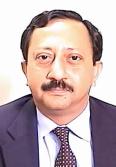
The interview below was conducted with Amit Mukherjee, a Lead Public Sector Specialist with the World Bank Group. Amit works in the WBG’s new Governance Global Practice, where much of his work centers on the Russian Federation. Amit was the project team leader for the recent Russian Federation Customs Development Project (CDP), which helped to reform and modernize the country's Federal Customs Service. Approved in 2003, the CDP wrapped up last year—with some impressive results. The Trade Post spoke with Amit about his experience in Russia, what makes reform in the country challenging, and where the two parties’ relationship can bring about positive outcomes in the future.
The Trade Post: You’ve been working in Russia for many years. How did you become interested in development and trade issues there?
Amit: I used to work in the ECA [Europe and Central Asia] region, from ‘96 to 2001. Then I moved to East Asia, where I worked until 2005. When I came back to ECA, starting in December 2005, that’s when I began really working on Russia.
At that time, we began working on a variety of issues across sectors and themes at the request of the Russian Federation. Very quickly we narrowed in on three or four key engagements. One of which was customs, because it was so incredibly important to the trade facilitation agenda. In the early 2000s, when the economy was still going through turbulent times, the importance of customs both from the revenue collection angle and the trade facilitation angle, were very important to the government.
I’ve been working on Russia ever since—among other countries—but that’s been a key focus of my work. In a sense, this continuity has helped our team to build client relationships; it’s helped us to build trust and credibility. I think it’s also helped the Bank Group to be seen by Russian authorities—and also the private sector—as a provider of knowledge and best practices, and it has helped us to work with them in adapting these practices to the institutional environment of Russia. But it’s been a very challenging engagement for the Bank.
The Trade Post: What are some of the challenges you have come across in Russia that you may not have in other countries?
Amit: I think every country is unique. But, having said that, there are a whole set of factors to do with Russia that make it both challenging and rewarding for the Bank as a global development institution.
First of all, the technical sophistication and the institutional capacity of our clients in Russia tend to be quite high. That’s both a reward and a challenge. It keeps us on our toes, being responsive and relevant, and providing the exact technical support that the government requests.
Secondly, I think if you look at the ECA region, it’s an incredibly challenging region, within which Russia is a very interesting country. We have the European Union; we have a lot of transition countries—both part of the former Soviet Union and part of the former Yugoslav Republic. We have countries that, over the last decade, have become new members of the EU. We’ve seen institutions change rapidly—and continue to change and evolve rapidly, which is something quite unique, if you look at it from a global perspective.
We also have an incredibly interesting mix of countries in this region. We have our IDA clients. Typically, they have challenges to do with capacity; they have challenges to do with governance. Certainly, there are challenges to do with reducing poverty and with helping the private sector grow and create jobs. In all of this, the trade agenda is incredibly important for every country.
Then we have IBRD countries. Some of which, like Russia, are also resource-rich. And these resource-rich countries typically don’t need the World Bank’s money, but have come to see the Bank as a professional development partner, which increasingly is helping them to focus on results and development outcomes. So, the mix of instruments we can offer ECA countries, including Russia, is very interesting.
The Trade Post: How did you take this into account when implementing the CDP?
Amit: Russia is a sophisticated client, which knows what it wants, in most cases. In the trade case, it seeks the Bank’s support in helping with its relationships with trading blocs, like the EU. The relevance of the CDP was that it focused on Russia’s northwestern border, a part of it, through which roughly 40 to 50 percent of Russia’s trade with the EU then flowed. So, strategically, it was an incredibly important project.
At the time, the private sector was growing incredibly quickly in some areas. We had challenges in terms of helping Russian Customs adapt its organizational practices and structure, over the years, to deal with this situation. We also had 9/11, after which many countries, including Russia, came to have significant security concerns. So, balancing priorities such as trade facilitation and security was a really challenging task. I think what the Bank has been able to provide to Russia has been appreciated by the authorities.
The Trade Post: With so many different factors at play, there must have been serious challenges in measuring performance to ensure these reforms were beneficial. Which of these did you find to be most challenging?
Amit: Well, this also ties into what makes Russia so interesting—the incredible variety inside Russia. You have regions that are incredibly rich and sophisticated; you have regions that are on the other end of the spectrum, and those in between. Russia has a vast swath of territory which, in the case of customs, means an incredibly long border—land and sea—which poses its own challenges in terms of measuring customs performance.
One of the things the project did was to help Customs think through a results framework and focus on results that actually show how it is performing. Looking at indicators like Doing Business tells you only a part of the story. And sometimes, as with the Doing Business indicators, governments feel that they do not tell the whole story.
In that sense, we were able to actually help Customs focus on what would be the appropriate indicators to measure its performance, taking into account the operating environment—but also keeping in view that Customs is actually only one of many agencies present at the international border.
Not everything that happens at the border depends on, or can be controlled by, Customs. Doing Business has a challenge in that respect. So, therefore, I think the work we did to shape Customs’ views on results indicators for the organization has also been helpful for them, and has helped them to move closer to their best-performing global peers.
The Trade Post: Now that the CDP is complete, where do you see cooperation between the WBG and Russia heading?
Amit: That’s pretty challenging and exciting. I think Customs may be open to looking for a way to continue its engagement with the Bank. We’ve had some informal discussions with them, and we are trying to figure out, with our country director and his team, what would be the best way to continue to help them.
Going forward, we will probably focus on two or three key issues. One could be to further help them refine their results indicators and provide them some benchmarks in terms of international good practices, which they can adopt or adapt to raise their game to the next level—building on the progress they’ve already made.
Secondly, I think we could help them undertake an institutional assessment as to where they stand as an organization: to look back over the last decade, to look forward to the WTO trade facilitation agenda, and to look forward also to the agenda that’s emerging in terms of the Eurasian Economic Union and the Customs Union that Russia has formed with Belarus and Kazakhstan—which may be expanding to other countries, as well. How that will work, in respect to customs overall, but also on the domestic and international operating environment, will be very interesting to see.
We could also help Customs in identifying good practices that it has instituted, and to help it think through the impact of these practices, so that this knowledge and this experience can be shared with other countries as part of the Bank’s global role in sharing knowledge and good practices.
Otherwise, we are continuing our dialogue with them. I do think there has been a critical mass of positive things that have happened out of the project that we can, as the Bank Group, help Customs define and disseminate—not just inside Russia, but also with partners like the World Customs Organization and with other countries in the region—and in other regions—seeking to modernize their own customs operations.
The Trade Post: How can reforms in Customs tie into other client needs?
Amit: I think another front here in our work, not just with Russia, but with other customs entities, is to look more towards the broader concept of border management. This involves not just helping customs, but the many other agencies frequently present at international borders. Look at it, for example, from the perspectives of trade facilitation, passenger traffic, and international migration. On all of which, we see much interest from customs and other entities not just in Russia, but across the world.
So for me, the message is, as the Bank now transitions into Global Practices, the biggest challenge for us is to make sure that our clients stay firmly in our sights, that we do not lose sight of how best to serve them, using the many instruments, facilities and knowledge that we have at the Bank Group, and providing seamless and better services to our clients.
I think that’s going to be our challenge going forward. So, it’s going to be exciting. I think it’s going to be positive. But it’s going to be a lot of hard work from all of us in the Bank—and that’s the way it should be.


Join the Conversation